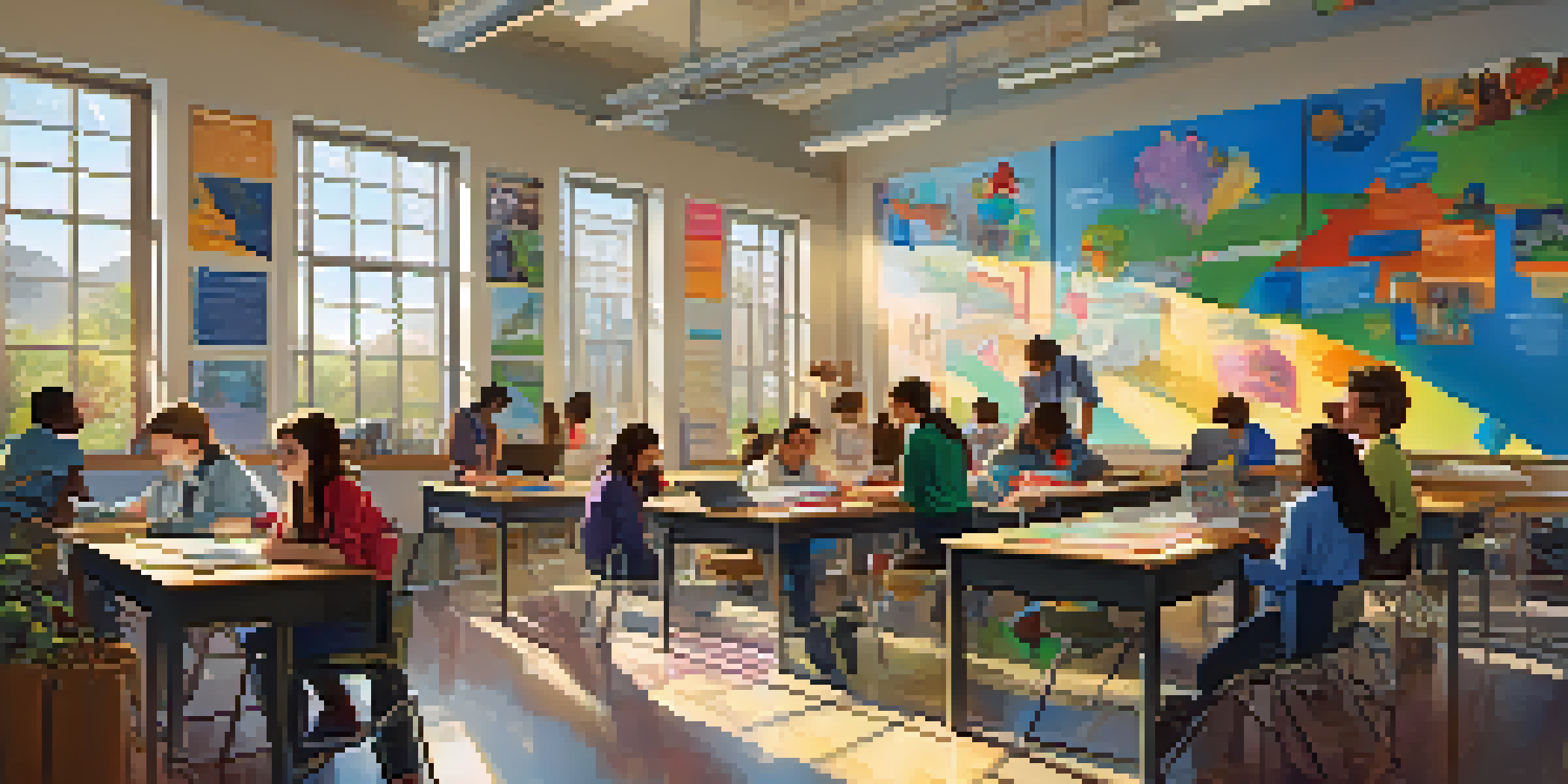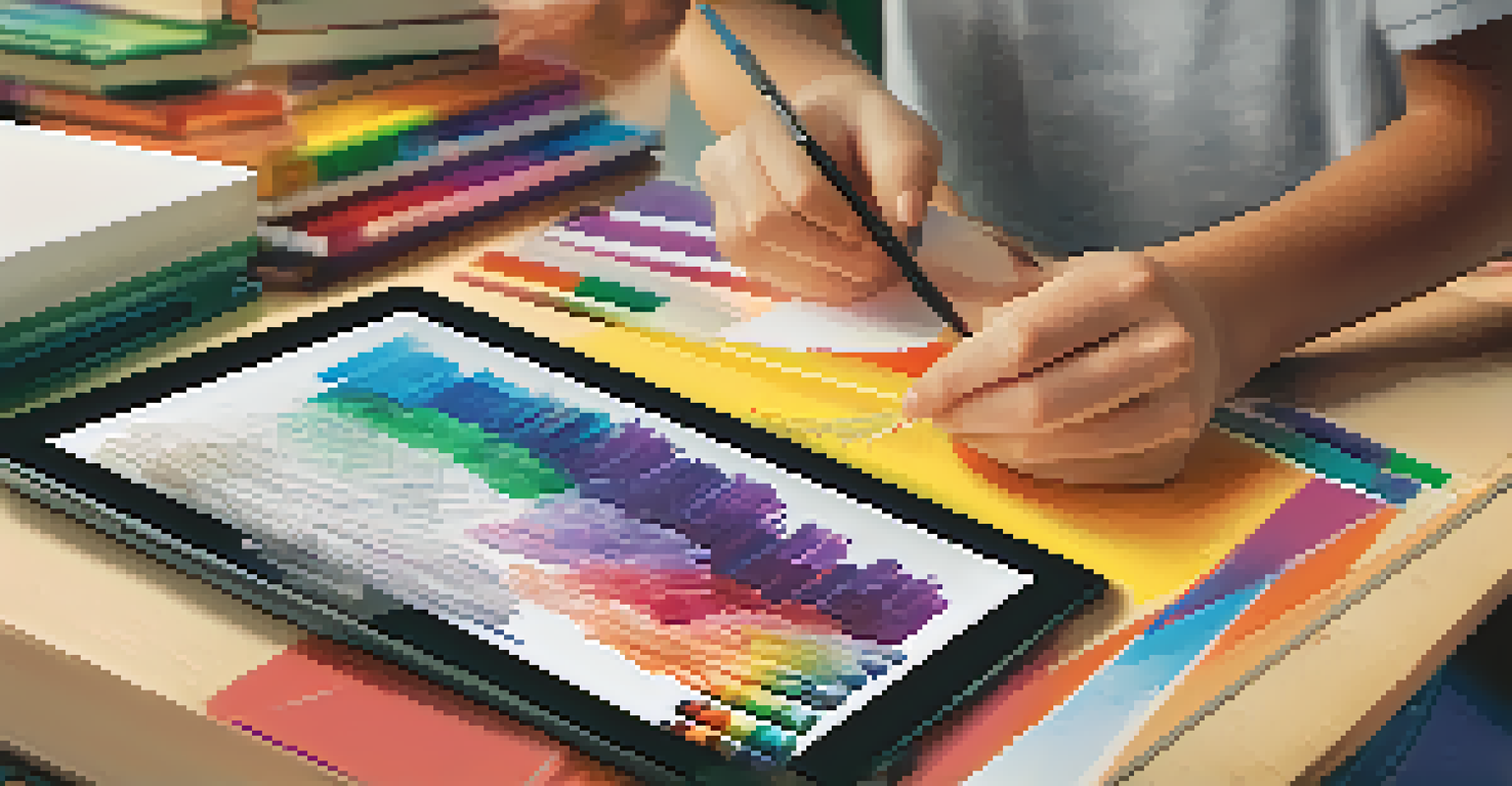Integrating Cross-Disciplinary Approaches in Assessments

Understanding Cross-Disciplinary Approaches in Education
Cross-disciplinary approaches involve blending insights from multiple fields to enrich learning experiences. This method recognizes that real-world problems often don’t fit neatly into one discipline, making it vital to integrate knowledge from various areas. For instance, a project on climate change can benefit from science, economics, and social studies, creating a more comprehensive understanding of the issue.
Education is not the filling of a pail, but the lighting of a fire.
By breaking down the silos between subjects, educators can foster critical thinking and creativity in students. This approach encourages learners to make connections, seeing how different disciplines inform and enhance one another. Ultimately, this leads to a more holistic educational experience, preparing students for complex challenges they might face in the future.
Moreover, incorporating different perspectives can lead to richer discussions and innovative solutions. When students see how disciplines intersect, they become more engaged and motivated to learn. This engagement is crucial in fostering a love for learning that extends beyond the classroom.
The Benefits of Integrative Assessment Strategies
Integrative assessment strategies allow educators to evaluate student understanding in a more comprehensive manner. Traditional assessments often focus on rote memorization, but cross-disciplinary assessments encourage students to apply their knowledge in real-world scenarios. For example, a project that requires students to create a sustainable business plan can assess their grasp of economics, environmental science, and marketing simultaneously.

These integrative assessments also promote collaboration among students, mirroring the teamwork often required in the workplace. When students work together on projects that span multiple disciplines, they learn to appreciate different viewpoints and expertise. This collaboration not only enhances learning outcomes but also builds essential communication skills.
Benefits of Cross-Disciplinary Learning
Integrating insights from multiple disciplines enhances critical thinking and prepares students for real-world challenges.
Furthermore, integrative assessments can provide educators with a clearer picture of student progress. By observing how students apply their knowledge across disciplines, teachers can identify strengths and areas for improvement more effectively. This holistic view allows for tailored instruction that meets the unique needs of each student.
Challenges of Implementing Cross-Disciplinary Assessments
While the benefits of cross-disciplinary assessments are clear, implementing them can pose challenges. One significant hurdle is the need for collaboration among educators from different disciplines. Teachers may have different priorities, assessment methods, and curriculum standards, making it difficult to create integrated assessments that align with everyone’s goals.
The best way to predict your future is to create it.
Additionally, there may be resistance from educators who are accustomed to traditional assessment methods. Changing established practices can be daunting, and some may question the effectiveness of integrative approaches. It’s essential for schools to provide professional development and support to help teachers understand the value of cross-disciplinary assessments.
Time constraints also play a role, as educators often struggle to fit comprehensive projects into already packed curricula. Finding the time to develop, implement, and assess cross-disciplinary projects requires careful planning and commitment. However, overcoming these challenges can lead to transformative educational experiences for both teachers and students.
Successful Examples of Cross-Disciplinary Assessments
There are numerous examples of successful cross-disciplinary assessments that highlight their effectiveness. One notable instance is the Project-Based Learning (PBL) approach, where students tackle real-world problems through collaborative projects that incorporate multiple subjects. For example, a project addressing water scarcity might include elements of science, geography, and social studies, culminating in a presentation of their findings.
Another effective method is the use of thematic units, where teachers from different subjects coordinate their lessons around a central theme. For instance, a unit on 'Health' could encompass biology, physical education, and nutrition, allowing students to explore the topic from various angles. This not only deepens their understanding but makes learning more relevant and engaging.
Challenges of Integrative Assessments
Implementing cross-disciplinary assessments can be difficult due to varying educator priorities and time constraints.
Additionally, schools that incorporate technology into their assessments often find it easier to blend disciplines. Digital tools can facilitate collaboration and creativity, enabling students to create multimedia presentations that draw from various subjects. These innovative assessments not only engage students but also prepare them for the digital world they will encounter in their futures.
Engaging Students Through Cross-Disciplinary Learning
Engaging students in cross-disciplinary learning can ignite their passion for education. When students see the real-life applications of their studies, they become more invested in their learning journey. For instance, hands-on projects that require skills from multiple fields can make learning more dynamic and enjoyable.
Moreover, cross-disciplinary approaches encourage students to take ownership of their education. When they are involved in designing projects that draw from various subjects, they feel a sense of agency and responsibility. This empowerment can lead to greater academic achievement and a lifelong love of learning.
Creating an engaging learning environment also means fostering curiosity and encouraging exploration. By allowing students to ask questions and seek answers across disciplines, educators can cultivate a classroom culture that values inquiry and innovation. This dynamic atmosphere is essential for preparing students for the complexities of the modern world.
The Role of Technology in Cross-Disciplinary Assessments
Technology plays a crucial role in facilitating cross-disciplinary assessments. Digital tools can streamline collaboration, enabling students to work together seamlessly, even if they are in different locations. For example, cloud-based platforms allow students to share their work and ideas in real time, fostering teamwork and creativity.
Moreover, technology can enhance the assessment process itself. Educators can use various software and applications to create interactive assessments that engage students more effectively than traditional tests. For instance, using simulations or gamified assessments can provide students with immediate feedback, helping them to learn and adapt their strategies in real time.
Role of Technology in Education
Technology facilitates collaboration and personalized learning, making cross-disciplinary assessments more engaging and effective.
Additionally, technology allows for a more personalized learning experience. Teachers can track student progress and adapt assessments to meet individual needs, ensuring that all students are challenged and supported. This flexibility is invaluable in a cross-disciplinary context, where students may have varying levels of expertise in different subjects.
Future Directions for Cross-Disciplinary Assessments
Looking ahead, the future of cross-disciplinary assessments appears promising. As education continues to evolve, there is a growing recognition of the importance of integrating various disciplines to prepare students for the complexities of the 21st century. Educational institutions are increasingly adopting innovative assessment strategies that reflect this understanding.
Moreover, with advancements in technology, the possibilities for cross-disciplinary assessments are expanding. Virtual reality, artificial intelligence, and other digital tools are paving the way for immersive learning experiences that blend multiple subjects effortlessly. This evolution can lead to assessments that are not only more effective but also more engaging for students.

Ultimately, the goal is to create a learning environment where cross-disciplinary assessments are the norm rather than the exception. By fostering collaboration among educators and embracing innovative approaches, we can equip students with the skills and knowledge they need to thrive in a rapidly changing world. The journey toward integrating these assessments is ongoing, but the rewards are well worth the effort.